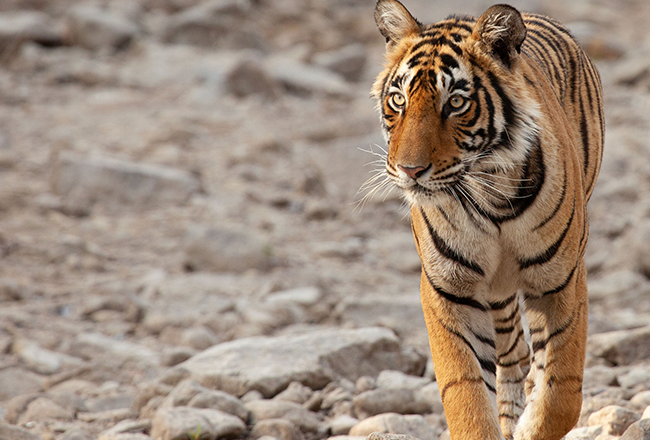Launching on the streaming giant on Earth Day (April 22), Life in Colour with David Attenborough is an expanded version of the BBC series Attenborough's Life in Colour, which aired earlier this year.
Over the series, Sir David unearths how colour, and how creatures perceive that colour, dictates the undulations of the animal kingdom.
The BBC delved into this unseen world over two fascinating episodes in March. The Netflix version includes a third ‘making of’ episode.
The new episode further explores the research provided by several University academics, and features interviews with Dr John Fennell and Dr Laszlo Talas about their research on tiger colours and mammal vision.
Life in Colour was made by Bristol’s Humble Bee Films, a company founded by Stephen Dunleavy, an alumni of the University of Bristol.
The programme’s Series Producer Sharmila Choudhury also studied at Bristol.
She said: “We are excited that Life in Colour will be launching worldwide on Netflix on April 22 (Earth Day).
“Netflix have such a global reach, that we are delighted to know that audiences around the world will be able to watch the series.”
Below is a breakdown of the research provided by University of Bristol academics.
Bengal tigers
A tiger’s vibrant orange stripes might be glaring obvious to us, but research by University of Bristol's Camo Lab found that it provides the perfect camouflage for their environment.
That’s because their primary prey, sambar deer, cannot readily tell apart red and green hues. Their colour blindness means tigers are extremely difficult to spot against green vegetation.
Deer’s vision is also considerably worse than ours, which means that tigers can easily fade into the background and stalk their next meal.
The researchers show that while tigers may be flame-coloured beacons to us, to deer they are slinking masters of disguise that are virtually invisible – a terrifying prospect.
Dr Laszlo Talas and Dr John Fennell are lead researchers on the project.
Laszlo said: “The colours of nature do not always make sense to us because we are looking at them through human eyes. The colours of animals should be assessed in the context in which they live: their environment, prey, predators and mates.”
John added: “It should be remembered that human vision is highly unusual among mammals. We have extremely sharp eyesight, and our eyes are trichromatic, which means that we have three types of colour receptors in our eyes - most other mammals are dichromats, with only two receptors that do not allow them to differentiate green from red.”

Fiddler crabs
These underwater critters are best known for the male of the species having one huge claw. But fiddler crabs have been hiding a far more exciting secret.
Recent discoveries, including by former Bristol PhD student Sam Smithers and academics Martin How and Nick Roberts, found that fiddler crabs can see a whole property of light that is invisible to humans.
Light can become ‘polarised’ when it reflects off a shiny surface like water. Humble Bee Films collaborated with an international group of scientists, including Sam and Martin, to develop an entirely new camera so we can see the world as fiddler crabs see it.
Sam spent almost a year embedded at Humble Bee Films, helping them create Attenborough’s Life in Colour.
Sam said: “Working on the series was a childhood dream come true. From the very start the series was incredibly ambitious and set out to show the natural world from a whole new perspective: that of the animals themselves.
“The series is not only a celebration of the beauty and colour of the natural world but is also a small triumph of science and film. It shows how science can, quite literally, change how we see the world."

Mantis Shrimp
Mantis shrimp are one of the few other animals that can see – and use - the polarisation of light. Amazingly, they can use this light to spot predators and even communicate with each other.
New camera technology allows viewers to see the world through their eyes for the first time.
Until recently we weren’t aware that this world of polarisation-based communication existed and we are only just beginning to understand its significance.
Dr Martin How, who studies mantis shrimp vision, said: “Mantis shrimps have one of the most astonishingly complex visual systems known to science.
“This makes it almost impossible to fully appreciate what the world might look like when seen through their eyes. Our new polarisation cameras help us get a step closer to getting this animal's perspective and it was great to be able to share this with viewers of the series.”

The production team
Humble Bee Films was founded by Stephen Dunleavy in 2009, following several years at the BBC’s wildlife documentary department, the Natural History Unit.
Both Stephen and the Series Producer Sharmila Choudhury studied at the University of Bristol.
Sharmila said: “Using new camera technologies we can see the world as animals see them – sometimes for the first time.
“For a long time scientists have been fascinated by why animals have so many different colours but only recently has modern technology allowed them to discover exactly how animals see and use colour.
“The expertise that the University of Bristol provided really helped us visualise what the world is like for animals.”

